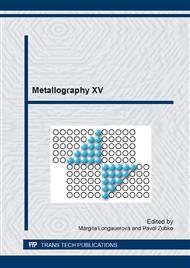p.408
p.415
p.421
p.427
p.431
p.437
p.441
p.445
p.449
Structure Stability of Ni-Base and Co-Base Alloys
Abstract:
This article summarises results of structure stability investigation of cast Ni-base and Co-base alloys after prolonged high temperature exposure at 900-1100 °C. Cast Ni (Co)-Cr-W-C alloys are resistant to high-temperature corrosion, due to high chromium content. Their heat resistance is caused by presence of carbides, which are stable at very high temperatures. Carbides precipitate in shape of large plate-like particles or carbide eutectics at casting cell boundaries, thus forming carbide skeleton of the alloy. Carbide morphology and temperature stability depends on chemical composition of the alloy, e.g. carbide content, type and content of carbide-forming elements. Microstructure changes were evaluated by stereological analysis and X ray-spectral microanalysis.
Info:
Periodical:
Pages:
431-436
Citation:
Online since:
April 2014
Price:
Сopyright:
© 2014 Trans Tech Publications Ltd. All Rights Reserved
Share:
Citation:


